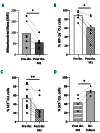Stem cell factor is implicated in microenvironmental interactions and cellular dynamics of chronic lymphocytic leukemia
- PMID: 32336682
- PMCID: PMC7927890
- DOI: 10.3324/haematol.2019.236513
Stem cell factor is implicated in microenvironmental interactions and cellular dynamics of chronic lymphocytic leukemia
Abstract
The inflammatory cytokine stem cell factor (SCF, ligand of c-kit receptor) has been implicated as a pro-oncogenic driver and an adverse prognosticator in several human cancers. Increased SCF levels have recently been reported in a small series of patients with chronic lymphocytic leukemia (CLL), however its precise role in CLL pathophysiology remains elusive. In this study, CLL cells were found to express predominantly the membrane isoform of SCF, which is known to elicit a more robust activation of the c-kit receptor. SCF was significantly overexpressed in CLL cells compared to healthy tonsillar B cells and it correlated with adverse prognostic biomarkers, shorter time-to-first treatment and shorter overall survival. Activation of immune receptors and long-term cell-cell interactions with the mesenchymal stroma led to an elevation of SCF primarily in CLL cases with an adverse prognosis. Contrariwise, suppression of oxidative stress and the BTK inhibitor ibrutinib lowered SCF levels. Interestingly, SCF significantly correlated with mitochondrial dynamics and hypoxia-inducible factor-1a which have previously been linked with clinical aggressiveness in CLL. SCF was able to elicit direct biological effects in CLL cells, affecting redox homeostasis and cell proliferation. Overall, the aberrantly expressed SCF in CLL cells emerges as a key response regulator to microenvironmental stimuli while correlating with poor prognosis. On these grounds, specific targeting of this inflammatory molecule could serve as a novel therapeutic approach in CLL.
Figures





Similar articles
-
Heightened BTK-dependent cell proliferation in unmutated chronic lymphocytic leukemia confers increased sensitivity to ibrutinib.Oncotarget. 2016 Jan 26;7(4):4598-610. doi: 10.18632/oncotarget.6727. Oncotarget. 2016. PMID: 26717038 Free PMC article.
-
Cells, cytokines, chemokines, and cancer stress: A biobehavioral study of patients with chronic lymphocytic leukemia.Cancer. 2018 Aug 1;124(15):3240-3248. doi: 10.1002/cncr.31538. Epub 2018 May 14. Cancer. 2018. PMID: 29757455 Free PMC article. Clinical Trial.
-
Bruton tyrosine kinase represents a promising therapeutic target for treatment of chronic lymphocytic leukemia and is effectively targeted by PCI-32765.Blood. 2011 Jun 9;117(23):6287-96. doi: 10.1182/blood-2011-01-328484. Epub 2011 Mar 21. Blood. 2011. PMID: 21422473 Free PMC article.
-
Ibrutinib for the treatment of chronic lymphocytic leukemia and mantle cell lymphoma.Drugs Today (Barc). 2014 Apr;50(4):291-300. doi: 10.1358/dot.2014.50.4.2133570. Drugs Today (Barc). 2014. PMID: 24918646 Review.
-
Ibrutinib (PCI-32765) in chronic lymphocytic leukemia.Hematol Oncol Clin North Am. 2013 Aug;27(4):851-60, x. doi: 10.1016/j.hoc.2013.01.006. Hematol Oncol Clin North Am. 2013. PMID: 23915749 Free PMC article. Review.
Cited by
-
Targeting mitochondrial bioenergetics by combination treatment with imatinib and dichloroacetate in human erythroleukemic K‑562 and colorectal HCT‑116 cancer cells.Int J Oncol. 2024 Apr;64(4):42. doi: 10.3892/ijo.2024.5630. Epub 2024 Mar 1. Int J Oncol. 2024. PMID: 38426621 Free PMC article.
-
DAZAP1 facilitates the alternative splicing of KITLG to promote multiple myeloma cell proliferation via ERK signaling pathway.Aging (Albany NY). 2022 Oct 13;14(19):7972-7985. doi: 10.18632/aging.204326. Epub 2022 Oct 13. Aging (Albany NY). 2022. PMID: 36242590 Free PMC article.
-
Expression and Purification of Human Stem Cell Factor and Its Effect on the Growth of A549 Cells.Protein J. 2025 Aug;44(4):377-386. doi: 10.1007/s10930-025-10273-w. Epub 2025 Jun 2. Protein J. 2025. PMID: 40457012
-
Serological biomarkers predict immune-related adverse events and clinical benefit in patients with advanced gastrointestinal cancers.Front Immunol. 2022 Sep 8;13:987568. doi: 10.3389/fimmu.2022.987568. eCollection 2022. Front Immunol. 2022. PMID: 36159840 Free PMC article.
References
-
- Fabbri G, Dalla-Favera R. The molecular pathogenesis of chronic lymphocytic leukaemia. Nat Rev Cancer. 2016;16(3):145-162. - PubMed
Publication types
MeSH terms
Substances
LinkOut - more resources
Full Text Sources

